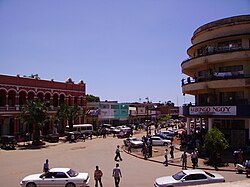Lubumbashi
| Lubumbashi | ||
|---|---|---|
|
|
||
| Coordinates | 11 ° 40 ′ S , 27 ° 29 ′ E | |
| Symbols | ||
|
||
| Basic data | ||
| Country | Democratic Republic of Congo | |
| Skin katanga | ||
| ISO 3166-2 | CD-HK | |
| height | 1259 m | |
| surface | 747 km² | |
| Residents | 2,190,000 (2017) | |
| density | 2,931.7 Ew. / km² | |
| founding | 1910 | |
| politics | ||
| mayor | Floribert Kaseba | |
|
City view of Lubumbashi
|
||
Lubumbashi (until 1966 Élisabethville or Elisabethstad ) is the capital of the resource-rich region of Haut-Katanga and with 2,190,000 inhabitants, after Kinshasa, the second largest city in the Democratic Republic of the Congo .
geography
The city is located in the extreme southeast of the Democratic Republic of the Congo at 1260 meters above sea level directly on the border with Zambia . It is located on the upper reaches of the Kafubu , which joins other rivers in the city and the surrounding area.
history
The city of Elisabethville ( Flemish Elisabethstad) was founded in 1910 by the Belgian colonial rulers , named after the Belgian Queen Elisabeth Gabriele in Bavaria .
In December 1941, Elisabethville was the scene of a strike against the harsher working conditions in the mines because of the war economy. At least sixty striking Congolese were shot dead by Force Publique soldiers on the Elisabethville soccer field.
In the secession period (1960-63) after independence, it was the capital of the short-lived Katanga state under the auspices of Moïse Tschombé . The national emblem of Katanga at the time, the three copper crosses still appear in the city coat of arms of Lubumbashi.
In 1966 the city got the name Lubumbashi as part of the Africanization set in motion by the dictator Mobutu Sese Seko .
In the Congolese civil war during the 1990s, Lubumbashi became a theater of war, and in April 1997 the Alliance des Forces Démocratiques pour la Liberation du Congo (ADFL) conquered the city. The rebel leader Laurent-Désiré Kabila proclaimed himself the new president of the country in Lubumbashi on May 17, 1997, the day after the ADFL had overthrown the long-term president Mobutu Sese Seko . From 1999 to 2003, Lubumbashi was the legislative capital of the Democratic Republic of the Congo before parliament moved back to Kinshasa .
population
As in most cities in the DR Congo, the population is growing rapidly. A population of over 6.1 million is expected in 2050.
Population development according to the UN
| year | population |
|---|---|
| 1950 | 96,000 |
| 1960 | 194,000 |
| 1970 | 325,000 |
| 1980 | 482,000 |
| 1990 | 722,000 |
| 2000 | 1,089,000 |
| 2010 | 1,642,000 |
| 2017 | 2,190,000 |
Economy and Transport
Lubumbashi has an international airport . The city is also on the railway line to Ilebo , Kindu , Sakania and Kolwezi and is considered the gateway to neighboring Zambia . The city is a center of copper smelting . Other mineral raw materials are also mined in their vicinity, such as cobalt and zinc ores . In the coal and steel sector , Lubumbashi is of paramount importance for the country and also the largest industrial and business center of the DRC. There are also textile , brick and food industries here.
education
In Lubumbashi there is a university founded by the Belgians in 1954/55, the Université de Lubumbashi , which is known by the acronym UNILU. Here at a linguistic congress from May 22nd to 26th 1974 the standardization and unification of the spelling of the national languages of Zaire , as well as the spelling of the national languages Kikongo , Lingála , Swahili and Tshiluba were regulated.
Attractions
In addition to the university and its library, the main attractions of the city include a botanical garden, a zoo and a brewery. The National Museum houses archaeological and ethnological exhibits from the region.
sons and daughters of the town
- Johnny Brouwers (* 1930), Belgian jazz pianist
- Dianik Zurakowska (* 1947), Belgian actress
- Golden Misabiko (* 1956), teacher and human rights activist, President of the Association Africaine de Defense des Droits de l'Homme (ASADHO; German for example: "African Association for the Defense of Human Rights")
- Placide Lubamba Ndjibu MAfr (* 1959), Bishop of Kasongo
- Gaston Kashala Ruwezi (* 1961), Bishop of Sakania-Kipushi
- Leon Nzama-Nawezhi (* 1973), Zambian boxer
- Christophe Ndabananiye (* 1977), Rwandan-German artist
- Gary Kikaya (born 1980), track and field athlete
- Danny Tshindind Kassap (1982-2011), Canadian athlete
- Christianne Mwasesa (* 1985), handball player
- Christian Kabasele (* 1991), Belgian soccer player
- Bismack Biyombo (born 1992), basketball player
Sports trivia
- On February 20, 2010, the draw for the 2012 African Cup of Nations qualification took place in Lubumbashi .
- Also in 2010, Tout Puissant Mazembe , an African club, made it into the final of the FIFA Club World Cup for the first time , but lost 3-0 to Inter Milan.
- TP Mazembe is the Congolese record champions. Other successful soccer teams in Lubumbashi are FC Saint Eloi Lupopo and CS Don Bosco .
Climate table
| Lubumbashi | ||||||||||||||||||||||||||||||||||||||||||||||||
|---|---|---|---|---|---|---|---|---|---|---|---|---|---|---|---|---|---|---|---|---|---|---|---|---|---|---|---|---|---|---|---|---|---|---|---|---|---|---|---|---|---|---|---|---|---|---|---|---|
| Climate diagram | ||||||||||||||||||||||||||||||||||||||||||||||||
| ||||||||||||||||||||||||||||||||||||||||||||||||
|
Monthly average temperatures and rainfall for Lubumbashi
Source: wetterkontor.de
|
|||||||||||||||||||||||||||||||||||||||||||||||||||||||||||||||||||||||||||||||||||||||||||||||||||||||||||||||||||||||||||||||||||||||||||||||||||||||||||||||||||||
Individual evidence
- ↑ David Van Reybrouck: Congo. A story. Paperback edition, Suhrkamp: Berlin 2013, ISBN 978-3-518-46445-8 , p. 232.
- ↑ City population 2050 | Sustainability Today. Retrieved July 24, 2018 .
- ↑ World Urbanization Prospects - Population Division - United Nations. Retrieved July 23, 2018 .
- ^ Liège: Lubumbashi [Democratic Republic of Congo ]. on www.liege.be (English)
Web links
- Maisha Lubumbashi Foundation
- Lubumbashi University (French)
- Luboom.com (Eng.)


